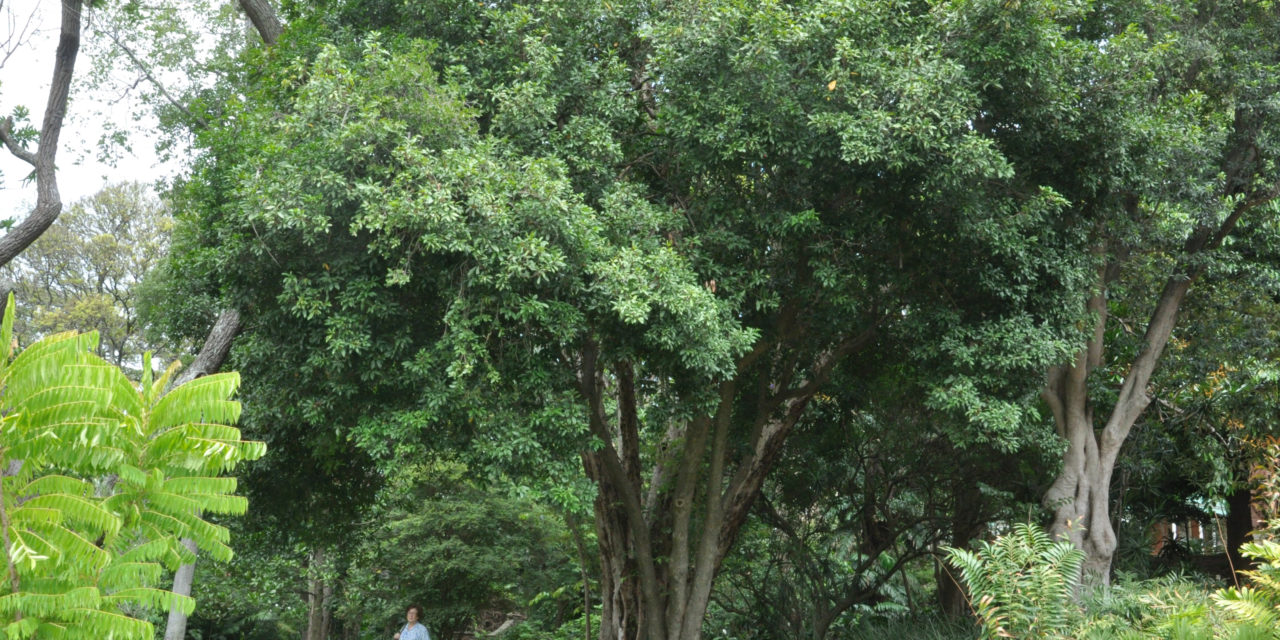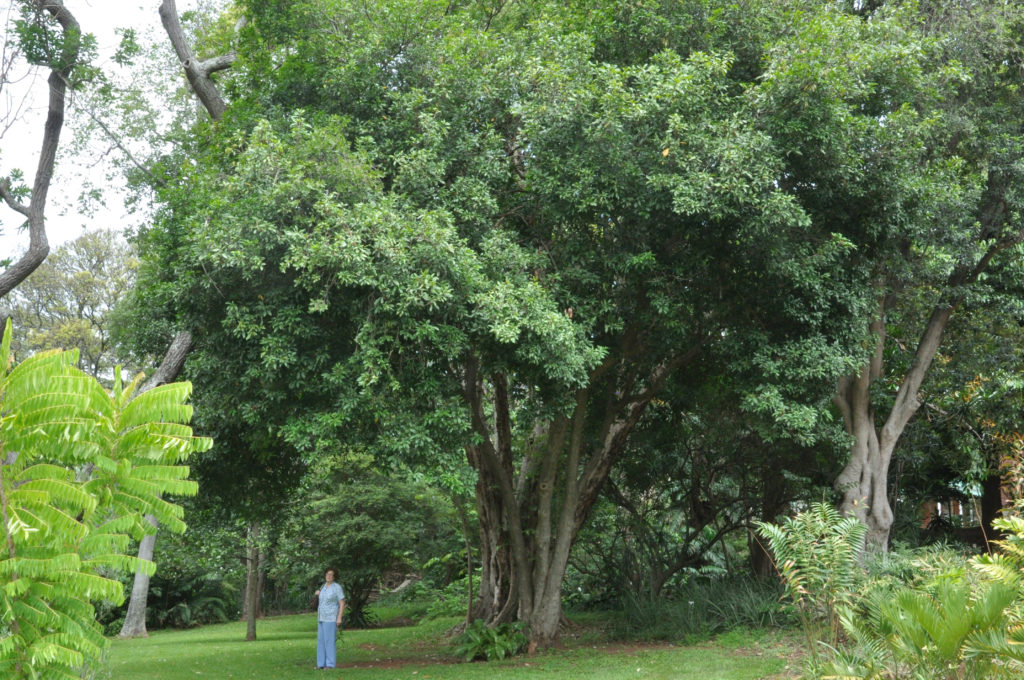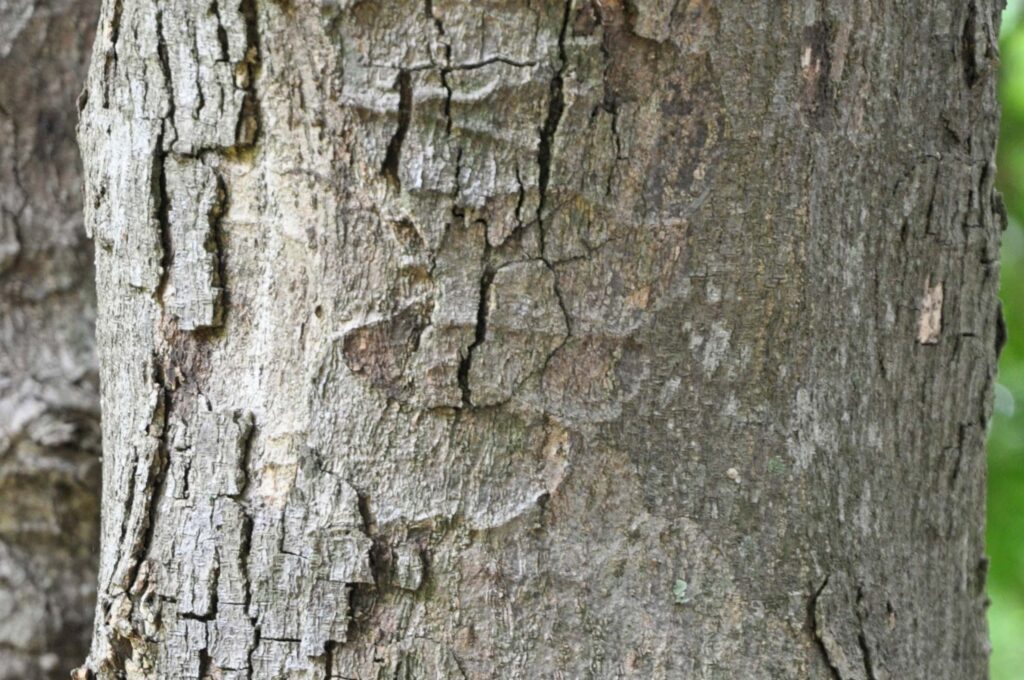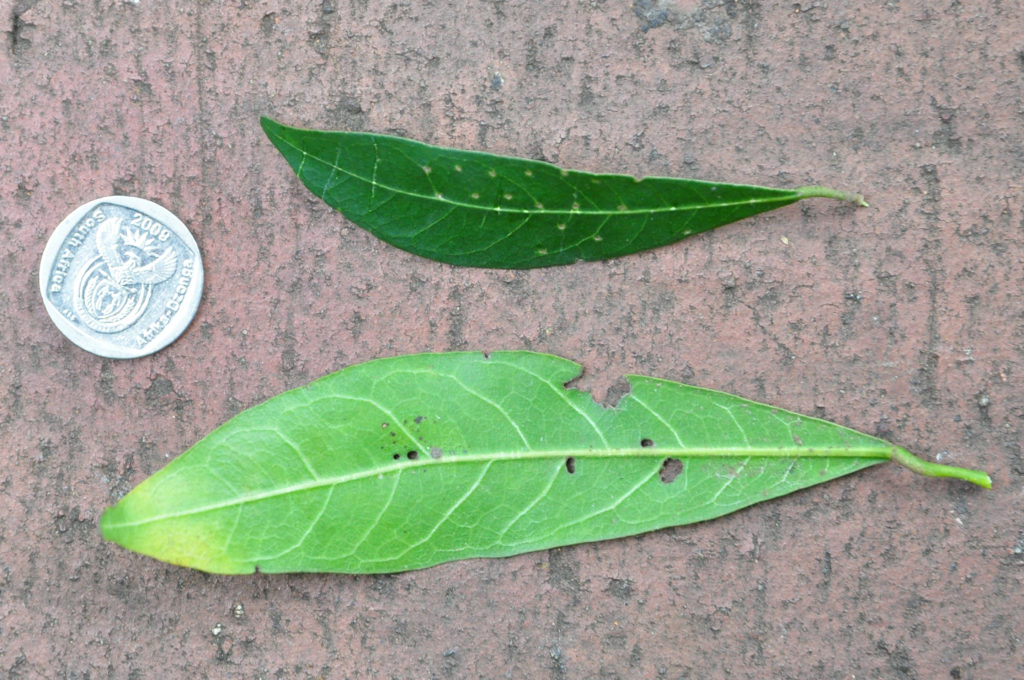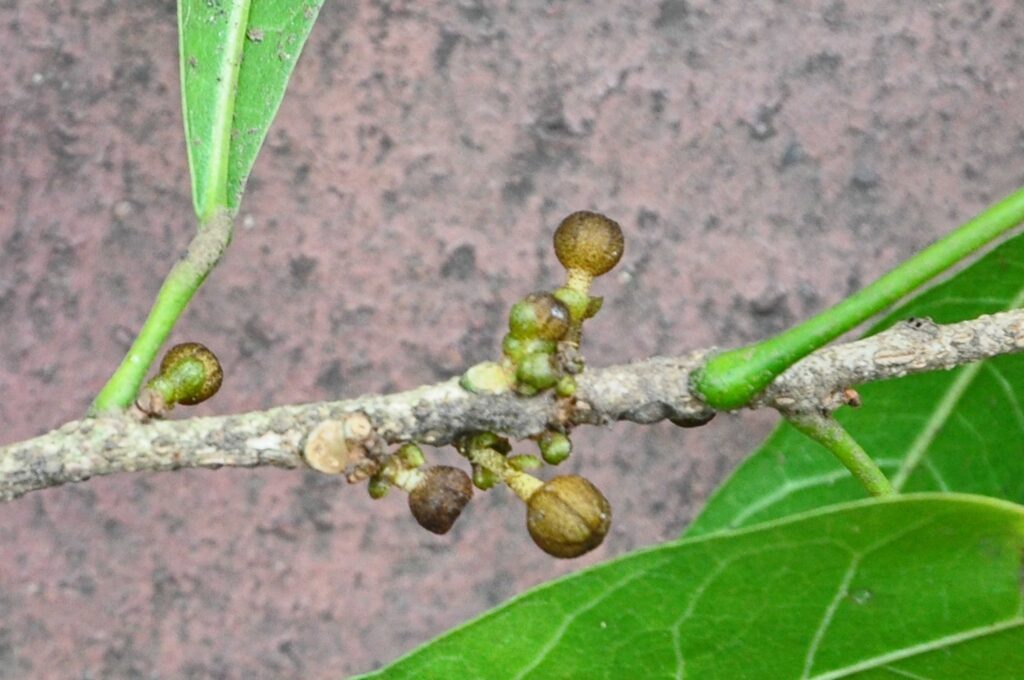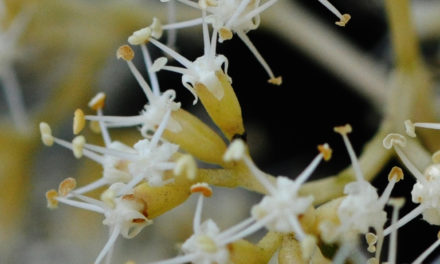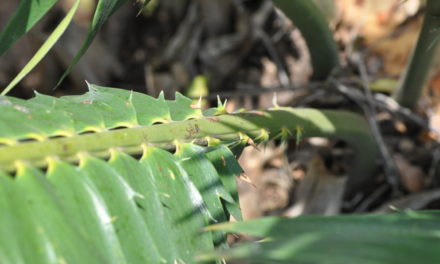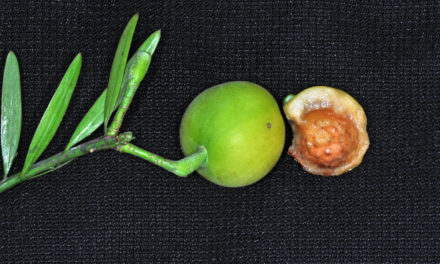Cola natalensis
General Info – summary
This evergreen Tree may reach 16m high. It has smooth bark that may flake. The simple, glossy and alternate or spirally arranged Leaves are glossy, dark green above and much lighter below. They are obovate-elliptic + entire margins. Petiole has a pulvinus. 5-merous Flowers lack petals and the sepals are petal-like. Female flowers have a compound pistil. Inedible orange Fruit has 4-5 carpels + reniform seeds.
Description
SA Tree No. 478.
Common names: (Afr) Gladdekola, Knuppelhout, Suidelike Kola. (Eng) Coshwood, Natal Cola, Southern Cola. (isiZulu) Iphumbulu, Umthenenende. (isiXhosa) Umthenenende, Umnqayana.
Family: Malvaceae. (Wild Pear, Gossypium – cotton, baobab and Hibiscus family). This family has 240+ genera and 4 200+ species. Most species are herbaceous, but a few are trees. Indigenous genera that have trees on this website includes Adansonia (baobab), Cola, Dombeya, Grewia, Hibiscus, Sparrmannia and Sterculia. Stems contain mucous canals. The usually alternate, often compound or palmately veined Leaves of all possess stipules and apart from Adansonia, remain simple. Flowers are regular, bisexual or unisexual and have 5 petals (Sparrmannia africana has 4) with regularly arranged overlapping edges. Petals are absent in Cola and Sterculia. There are 5 to many stamens with filaments often united into a staminal tube. This surrounds the superior Ovary with axile placentation and its simple Style and capitate or lobed Stigma. Fruits are usually nuts, schizocarps or loculicidal capsules.
Name derivation: Cola an African common name. natalensis from Natal, now Kwa-Zulu Natal. There are 2 species in southern Africa. This plant can be confused with the second one – Cola greenwayi but the latter has brownish hairs on young branches, which are lacking in Cola natalensis.
Conservation: National Status: L C. (Least Concern). Assessed: Raimondo et al. (2009).
Tree
This small to medium sized, evergreen Tree (photo 217) is up to 16m high – usually less. The smooth dark grey, Bark may flake into small patches on older stems (photo 215) and may be shallowly dimpled. The Branches are crooked and only initially hairy. Leaf scars are visible on youngish stems (photo 218 – under Fruit).
- 217. 2015/02/09. Durban BG. Photo: David Becking.
- 215. 2015.02/09. Durban BG. Photo: David Becking.
Leaves
On this evergreen tree, the alternate or spirally arranged Leaves tend to droop and are simple (have a single blade that may have incisions but are not deep enough to divide the leaf into leaflets). Young leaves have a few stellate hairs. The leaves have Margins that are entire (with a continuous margin, not in any way indented). The Apex and Base both taper and may be sharply or bluntly tipped (photo 219). The leaves are glossy, dark green above and much lighter below (photo 219). The relatively narrow Blade is obovate (like an upside-down egg with the narrower end near the base) to elliptic (Oval in outline, with narrowed to rounded ends and widest near the middle). They are up to 20 x 6,5cm. The Midrib has 7 to 12 “pairs” of visible lateral veins that protrude below. These veins curve and join before reaching the margin. The hairless Petiole (leaf stalk) is smooth, up to 5cm long, slightly swollen at the end (photo 218 under Fruit), and may be darker just prior to joining the blade. This is called a pulvinus (a joint-like thickening in the petiole or petiolule). [In Cola greenwayi the petiole is velvety – having a smooth, soft appearance, feel, or taste]. Stipules (basal appendage of the petiole) are present but caducous (an organ or part which is easily detached and shed early) and are only visible on seedlings. Fallen leaves leave a leaf scar (photo 218 under Fruit).
- 219. 2015/02/09. Durban BG. Photo: David Becking.
Flowers
The small pale yellow cup-shaped Flowers are unisexual and monoecious (separate male and female flowers present on the same tree) or dioecious (having male and female parts on separate plants). Flowers have brown hairs and scales. They may appear solitary, on short side branches or in small axillary clusters. Flowers may also be cauliflorous (the production of flowers and fruits directly from the branches or trunks of woody or tropical plants) and not from new growth or shoots. Flowers lack Petals but the Calyx has petal-like externally pubescent (with dense fine, short, soft hairs – downy) Sepals – each about 6mm long. These are coloured reddish-brown by the short soft rusty hairs. The lobes extend almost to the base. Male flowers are small. The 10 Stamens are usually united into a tube around the rudimentary ovary. The sessile Anthers are 2-thecous (have 2 pollen sacs) and dehisce through longitudinal slits. In the Female flowers, there is a single compound Pistil (a unit of the Gynoecium, the female element of the flower, composed of the compound Ovary, Style and Stigma) and the sessile Ovary is superior (said of an ovary that is free from the calyx or perianth). There are up to 5 Styles present, each with stigmas that are club-shaped and recurved. There is a ring of rudimentary Staminodes (sterile stamens) around the base of the ovary. (Oct-Nov).
Fruit
Small hairs cover the orange-yellow Fruit, which is smooth, leathery and warty. The fruit is up to 4 x 3cm (photo 218). As the fruit matures the 4-5 carpels, (female reproductive structures that encloses the ovule/s) enlarge into separate, pod-like, hard, woody structures that resemble separate fruits. The Seeds lack endosperm (the starch and oil-containing tissue of many seeds; often referred to as the albumen) and usually have 2 cotyledons (seed leaf; primary leaf or leaves in the embryo). (Dec-Mar).
- 218. 2015/02/09. Durban BG. Photo: David Becking.
Distribution & Ecology
The genus Cola has two species in southern Africa. They are Cola greenway and Cola natalensis. Details of the latter occur in this website. These Trees are not common but do occur naturally in the Eastern Cape, KwaZulu-Natal e.g., Hawaan Forest near Umhlanga Rocks in KwaZulu-Natal, and in Mpumalanga. Beyond South Africa Cola natalensis is also found in, Eswatini (Swaziland), Mozambique, Zimbabwe and northwards into Tropical Africa. It is common on mountainsides, moist savanna (is a rolling grassland scattered with shrubs and isolated trees, which can be found between a tropical rainforest and desert biome) and evergreen forests from sea level to an altitude of 1 000m. Black rhino eat both the Bark and Leaves. The Paradise Skipper (Abantis paradisea) butterfly has quick darting flight habits and have larvae that feed on this plant. Fruit flies (Ceratitis rosa) are often a problem on Cola natalensis. In northern KwaZulu-Natal, its place is taken by Cola greenway.
Ethnobotany
The reddish Wood is hard and durable but straight pieces are rare. The wood is used for making attractive walking sticks, small carvings, disselbooms (main haulage shafts of a wagon or cart) and hut building. The Fruit is inedible. Parts of the tree are used in traditional medicine.
References
Boon, R. 2010. Pooley’s Trees of eastern South Africa. Flora and Fauna Publications Trust, Durban.
Coates Palgrave, M. 2002. Keith Coates Palgrave Trees of Southern Africa, edn 3. Struik, Cape Town.
Foden, W. & Potter, L. 2005. Cola natalensis Oliv. National Assessment: Red List of South African Plants version . Accessed on 2025/01/12.
Lawrence, G. H. M, 1951. Taxonomy of Vascular Plants. The Macmillan Company, New York. Tenth Printing 1965.
Palmer, E. & Pitman, N. 1972. Trees of southern Africa. Balkema, Amsterdam, Cape Town.
van Wyk, B. & van Wyk, P. 1997 Field guide to Trees of Southern Africa. Struik, Cape Town.
http://www.plantwise.org/KnowledgeBank/Datasheet.aspx?dsid=12378
http://abcjournal.org/index.php/ABC/article/viewFile/1317/1277
http://posa.sanbi.org/flora/browse.php?src=SP
http://www.theplantlist.org/tpl1.1/record/kew-2730656

